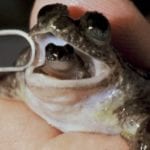 History
History  History
History  Technology
Technology Top 10 Everyday Tech Buzzwords That Hide a Darker Past
 Humans
Humans 10 Everyday Human Behaviors That Are Actually Survival Instincts
 Animals
Animals 10 Animals That Humiliated and Harmed Historical Leaders
 History
History 10 Most Influential Protests in Modern History
 Creepy
Creepy 10 More Representations of Death from Myth, Legend, and Folktale
 Technology
Technology 10 Scientific Breakthroughs of 2025 That’ll Change Everything
 Our World
Our World 10 Ways Icelandic Culture Makes Other Countries Look Boring
 Misconceptions
Misconceptions 10 Common Misconceptions About the Victorian Era
 Mysteries
Mysteries 10 Strange Unexplained Mysteries of 2025
 History
History 10 Things You Didn’t Know About the American National Anthem
 Technology
Technology Top 10 Everyday Tech Buzzwords That Hide a Darker Past
 Humans
Humans 10 Everyday Human Behaviors That Are Actually Survival Instincts
Who's Behind Listverse?

Jamie Frater
Head Editor
Jamie founded Listverse due to an insatiable desire to share fascinating, obscure, and bizarre facts. He has been a guest speaker on numerous national radio and television stations and is a five time published author.
More About Us Animals
Animals 10 Animals That Humiliated and Harmed Historical Leaders
 History
History 10 Most Influential Protests in Modern History
 Creepy
Creepy 10 More Representations of Death from Myth, Legend, and Folktale
 Technology
Technology 10 Scientific Breakthroughs of 2025 That’ll Change Everything
 Our World
Our World 10 Ways Icelandic Culture Makes Other Countries Look Boring
 Misconceptions
Misconceptions 10 Common Misconceptions About the Victorian Era
 Mysteries
Mysteries 10 Strange Unexplained Mysteries of 2025
10 Most Oddball Communication Methods In Nature
Every day, humans express themselves in a myriad of weird and wonderful ways. Our body language, facial expressions, and tone of voice all convey some form of meaning. From a subtly raised eyebrow to a sharp rejoinder, these signals dominate our every social interaction.
While we are intimately familiar with our own methods of communication, the rest of the animal kingdom has a few surprises up its sleeve.
Nature has conjured an amazingly diverse range of communication strategies. For example, some insects use chemical signaling to create trails. New-world monkeys wash themselves in their own urine to attract mates. And meerkats use auditory calls to warn each other about dangerous predators.
These messages are part of a fascinating evolutionary arms race. Animals on the bottom rung of the food chain may send bogus messages to confuse eavesdropping predators. Other times, a predatory animal will broadcast deceptive signals, luring its prey into a brutal death trap.
As this list reveals, having an effective communication strategy can be the difference between life and death. To quote the English poet Alfred Tennyson: “Nature, red in tooth and claw.”
10 Deaf Moths Click Their Wings
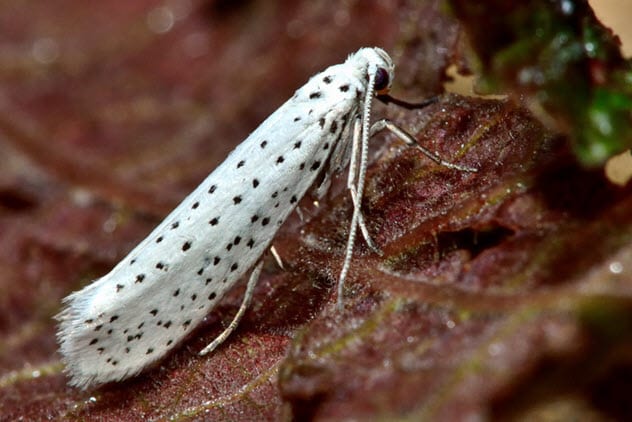
Many insect eaters feast on a nutritious diet of mosquitoes and moths. But several species of moth are starting to fight back. Curiously, the Yponomeuta moth “talks” its way out of trouble.
The deaf creature’s wings are packed with sound-producing structures called tymbals. As the critter beats its delicate wings, these translucent structures twist and turn. This buckling triggers a series of ultrasonic clicks that its nemesis, the predatory bat, detects via echolocation.
But what do these signals do?
While some moths produce ultrasound to acoustically “jam” a bat’s sonar capabilities, the Yponomeuta has its own cunning trick. They mimic the clicking noises of the more toxic tiger moths. Over time, the bats associated these clicks with poisonous moths and so learned to avoid them.[1]
Some grass moths whisper “ultrasonic courtship songs” to serenade potential mates. As part of the species’ survival strategy, the males can only beam these sounds over a very short distance. Too much excitement and the moth could end up as bat food.
9 Tree-Cuddling, Urine-Spraying Bears
Bears have a strange way of making themselves known. These solitary creatures are often seen rubbing their backs against trees, almost as if they have an interminable itch. By the end of this display, the tree is peppered in the creature’s thick fur. The scratches, bite marks, and oozing tree sap send a clear message to other bears in the region: “This is my territory.”
Brown bears use a range of chemical signals to mark territory and assert their dominance. For example, anal gland secretions and urine are commonly sprayed across the local flora. Bears have an astonishing sense of smell, so these chemical signposts are easily detected.
Large brown bears use the trees to send messages about their status in the hierarchy. Subordinate bears then decode these messages to avoid potentially deadly confrontations with dominant bears. According to biologist and bear researcher Melanie Clapham, “rub trees” ensure that bears at every level of the hierarchy have safe access to females and feeding sites.
It is likely that some cubs use rub trees to protect themselves. Adult males have been known to kill cubs in a bid to mate with new mothers. Researchers have evidence to suggest that these cubs will try to ape the smell of a dominant bear by pressing up against scent-laden trees.[2]
Both brown bears and polar bears have large sweat glands between their toes. As they stomp around on all fours, the creatures’ paws release distinctive scents. This pungent aroma reveals a bear’s sex and reproductive status. Sometimes, the bear will go that extra mile, mashing its own urine and sweat secretions into the ground.
8 Sneeze For Democracy
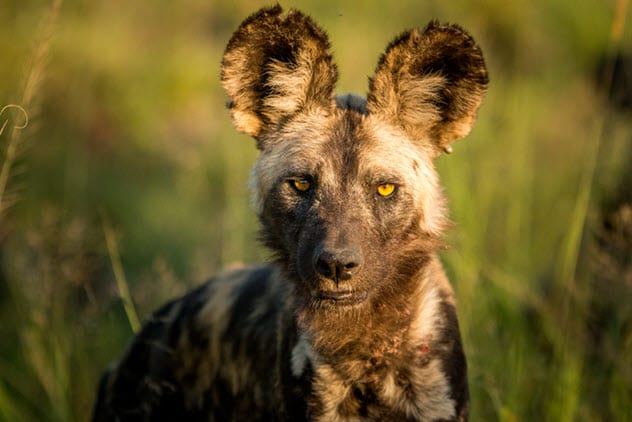
The African wild dog (Lycaon pictus) is an endangered species native to sub-Saharan Africa. These pack hunters typically fall in line with the strongest members of their group. The dominant male bonds with the dominant female, and the pair govern the pack’s day-to-day activities. But the dogs seem to show a curious appreciation for democracy, too.
In 2014, a team of researchers went out to the Botswana Predator Conservation Trust to study the behaviors of the wild dogs. The zoologists were surprised to learn that the dogs were conducting their own social rallies.
The vote system was even more perplexing. After forming an assembly, the wild dogs would sneeze at one another to indicate their preferences. The more sneezes issued, the more likely the pack commenced a hunt.
A “sneeze threshold”—called the “quorum”—is needed before the pack comes to an agreement. If the social rally is initiated by a lower-ranked dog, around 10 sneezes are needed. But if a dominant male or female calls a rally, the threshold could be as low as three sneezes.[3]
Similar coordination has been observed in meerkats. A chorus of “moving calls” is needed to bring about a democratic consensus over where to forage. When three or more meerkats issue the call, the mob must work together to find a new site.
7 The Internet Of Fungus
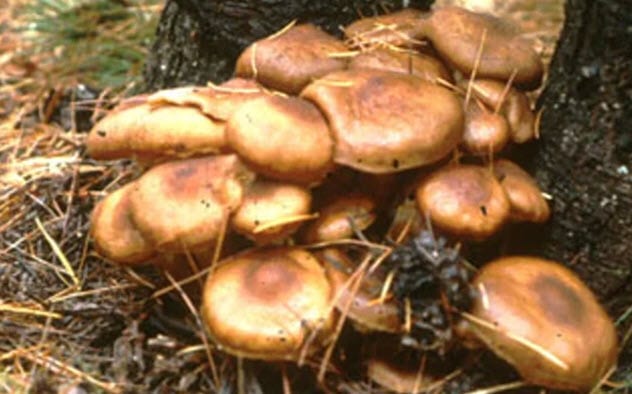
Beneath our very feet lies a giant information superhighway, similar to the Internet but biological. This network is comprised of tiny fungal threads called mycelium. Hundreds of millions of years ago, some of these networks even seeded enormous tree-sized fungi that burst from the soil.
Today, these sprawling networks can grow to astronomical sizes. The soil around the Blue Mountains of Oregon is home to a fungal network that spans a staggering 2,384 acres. This 2,400-year-old fungus is Earth’s largest known organism.[4]
Fungi have a mutually beneficial relationship with 90 percent of all land-based plants. Mycelial networks form around the roots of plants and trees, protecting them from harmful bacteria and improving nutrient uptake. They decompose plant matter, maintain healthy soil, and feed nutrients from one plant to another.
For example, members of many tree species use these networks to share nutrients with young, undernourished trees. In exchange for this service, the fungi receive a source of carbohydrates.
Individual plants can essentially talk to one another through the mycelial network. In 2010, Chinese researchers discovered that tomato plants use these fungal structures to send distress signals.
After encountering a deadly organism, infected plants would use the mycelial network to share information with their neighbors. The healthy plants would then produce defensive enzymes to resist the disease.
6 Spit-Swapping Ants Leave Pheromone Trails
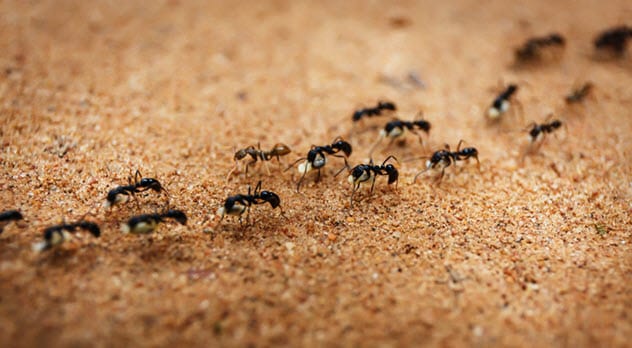
Ants are highly social insects that live and work in large colonies. Coordination of nest construction, navigation, and colony defense are all achieved using a range of biological tools.
Ants often use pheromones to mark a food trail, showing other colony members where to forage. Other ants detect these chemical signals with their antennae and join the trail. As more and more ants strap on their work boots and join the trail, the pheromone scent grows stronger. This entices even larger numbers of ants to join in.
An ant secretes a cocktail of pheromones from the glands lining its abdomen, thorax, anus, and feet. The composition of this pheromone mixture plays a crucial role in communicating different ideas about a food trail. A trail’s scent tells an ant about both rewarding and unrewarding paths. Short-term scents can even serve as “attack signals” which direct the colony toward nearby prey.
Ants also exchange saliva as a means of recognizing different nest mates. This rather curious display, which looks a lot like mouth-to-mouth kissing, is called trophallaxis. The saliva contains pheromones, hormones, food, and genetic material. This exchange provides chemical information on the colony and reproductive status of a worker.[5]
5 The Honeybee Waggle Dance
During the spring, honeybee workers scour the countryside in search of nectar, pollen, water, and tree resin. As with the humble ant, each individual bee must communicate its findings with the rest of the hive. The honeybee uses a very specific dance routine to do this: the waggle dance.
At first glance, the waggle dance may appear rather haphazard. But the carefully choreographed routine actually conveys a lot of very useful information.
First, the bee must grab the attention of its fellow nectar lovers. It clambers atop another bee and vibrates rapidly. When a large enough crowd has formed, the bee starts to bust some moves. It waggles its body while moving in a straight line. The duration of this “waggle run” tells the others how far away the flower patch is.
The dance direction tells the bees which way they must fly with respect to the Sun. If the dancer is jiggling upward, then the food is located in the direction of the Sun on the horizon. If the bee is facing downward, then the food is located in the opposite direction to the Sun on the horizon.
The dancing honeybee may provide onlookers with a sample of what she has found, regurgitating some of the nectar from her stomach. Before taking flight, the colony members sniff the dancer to get a better idea of what flower patch they are looking for.[6]
4 African Knifefish Use Electrolocation

In 1949, British zoologist Hans W. Lissmann was enjoying a trip to the London Zoo when he noticed something unusual in one of the aquarium tanks. One of the fish demonstrated an incredible aptitude for swimming in reverse, blindly weaving around obstacles dotted about the tank.
It was the African knifefish. Lissmann already knew that the creature had an organ that could generate weak electric discharges. But he began to wonder whether these discharges were helping the fish navigate.
As luck would have it, Lissmann was given an African knifefish as a wedding gift. Within a short time, the researcher had answers. It became clear that the fish was transmitting electric fields from a small organ in its tail.
The distortions in these signals, which are detected via receptors in the skin, told the fish about its environment. Incredibly, the creature could distinguish between different materials based upon an object’s electrical conductivity.
Mormyrid fish not only use these electric organs to hunt in the murky depths of rivers and lakes but to also send coded messages to one another. Different discharge patterns indicate the behaviors, sex, species, and social status of the fish.
A particular type of mormyrid, the bulldog fish, uses electricity as part of its courtship ritual. The females are attracted to longer pulses as they are a sign of a strong partner. There is a slight problem, though. Predatory catfish have been known to intercept these signals, catching the crooning male with his pants down.[7]
3 Crested Pigeons Use Wing Whistling
Crested pigeons have evolved a warning system that broadcasts information about potential predators. The crested pigeon, Ocyphaps lophotes, is native to mainland Australia. The bird has a very distinctive appearance with its green-purple wings and mohawk-like crest.
When startled, the bird launches into the sky and emits a series of panic-induced whistles. But these noises are not produced by the bird’s vocal cords. They are the result of vibrations in a part of the wing—specifically, the eighth primary feather.
With each upstroke of the wing, a low-frequency note is generated. Each downstroke produces a high-frequency note. The bird frantically flaps its wings while trying to escape an incoming predator. This triggers a quick succession of high and low notes, which other crested pigeons interpret as a warning signal.
Crested pigeons always whistle when taking off. However, a relaxed takeoff does not initiate any sort of warning signal. This is because the wing beat is too slow, resulting in a slower tempo of notes.[8]
2 White-Lipped Frogs Communicate via Seismic Signals
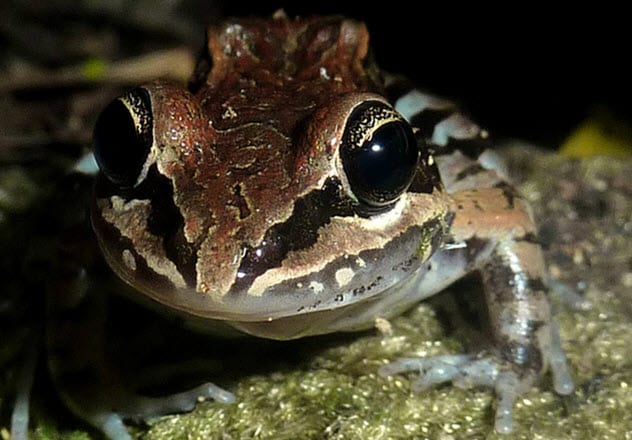
During the 1980s, physiologist Peter Narins participated in a field trip to the El Yunque National Forest of Puerto Rico. The animal kingdom asserted its might, filling the professor’s ears with “a cacophony as loud as a subway train passing 6 meters (20 ft) away.” But Narins took a much keener interest in what was happening closer to the ground.
While observing the white-lipped frog, Leptodactylus albilabris, Narins noticed some unusual behavior. The nocturnal amphibian buried its rear in the ground and repeatedly inflated its vocal sac. The research team used geophones to listen in. As the frog chirped away, its sac would strike the ground and generate a sequence of thumps.
It turns out that this ritual was part of a territorial announcement issued by male frogs. The white-lipped frog is small and cannot compete with the bellowing croaks of much larger frogs. So the clever little guy evolved a rather ingenious work-around.
The inner ear of L. albilabris boasts a crystal-filled structure—the sacculus—which behaves like a biological seismometer. When the frog’s vocal sac inflates, the resultant vibrations travel through the ground and trigger the sacculi of nearby frogs. These signals allow male frogs to pinpoint one another and maintain their distance.
Narins went one step further and created his own faux frog out of spare typewriter parts. When he mimicked the thumping pattern, all the frogs within a 3-meter (10 ft) radius would respond in unison.[9]
1 Elephants Use Sign Language, Sniffing, And Rumbles
Elephants are the masters of communication. These gentle giants communicate using touch, smell, acoustics, and sign language.
Elephant researcher and biologist Joyce Poole discovered that elephants use over 200 different calls and gestures. After studying the creatures for 40 years, Poole can reliably predict what an elephant will do based upon its posture, movement, and sounds. From the curl of a trunk to the flick of a head, each movement is deliberate and meaningful.
“I noticed that when I would take out guests visiting Amboseli [National Park in Kenya] and was narrating the elephants’ behavior,” explained Poole, “I got to the point where 90 percent of the time, I could predict what the elephant was about to do.”
Poole used her findings to create a database of elephant language. She even helped develop an online translator. Like humans, elephants have different personalities. Some elephants are coy and subtle. Others are expressive and outgoing.
An elephant that stands tall and spreads its ears is projecting aggression. Head waggling is a sign of playfulness. Foot-swinging gestures are a way of telling the herd which way to travel. And trunk “high-fiving” is seen during times of celebration.
An elephant adopts the “freeze position” when it espies potential danger. It alerts its allies by trumpeting a mix of high- and low-frequency sounds.[10] The high-frequency sounds travel a short distance through the air. Low-frequency rumbles travel seismically over a much greater distance, typically between 8–10 kilometers (5–6 mi).
The Earth’s vibrations are detected in special nerve endings in the elephant’s trunk and feet. This allows elephants to talk to each other when separated. An elephant can even sense a zeal of stampeding zebra from several miles away.
An elephant’s trunk is essential for communication, too. Their trunks are packed with millions of olfactory receptor cells, giving elephants an incredible sense of smell.
Elephants will sniff and taste each other’s urine, feces, and secretions for chemicals. During bonding ceremonies, the females become so excited that they defecate and urinate everywhere. Important information about a herd member’s physiological state is encoded within these scents.
The trunk is also used during social rubbing to reinforce bonds between close family members.
Read about more bizarre ways that animals communicate on 10 Incredibly Odd Ways That Animals Communicate With Each Other and 10 Bizarre Facts About Animal Language.





